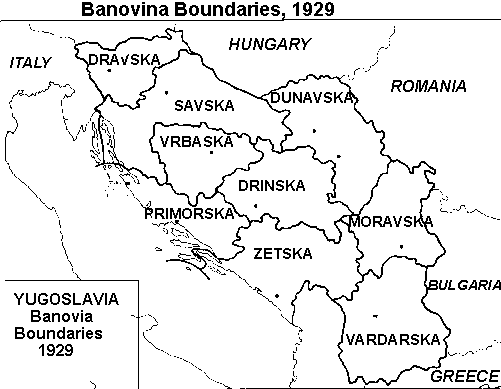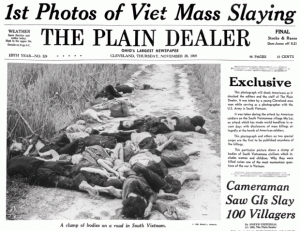
Views: 423
Yugoslavia (the “land of South Slavs”) was a Balkan multi-ethnic state which emerged from the ruins of the Austrian-Hungarian Monarchy (est. 1867) and was officially announced to exist on December 1st, 1918 under the original name of the Kingdom of Serbs, Croats and Slovenes.[i] The name was changed in June 1929 to the Kingdom of Yugoslavia. The country existed under such name till April 1941 when it was destroyed, occupied, and divided by the Axis Powers and their Balkan satellites. Legally, the state emerged from the 1917 Corfu Pact signed by the Government of Serbia on one hand and the South Slavic political representatives from Austria-Hungary (the Yugoslav Committee) on the other. Up to the end of WWII, there were recognized three branches of the same Yugoslav tree: the Serbs, the Croats, and the Slovenes. That was for the first time in history that the South Slavs began to live together in their own national state.
 Administrative division of Yugoslavia from 1929 to 1941
Administrative division of Yugoslavia from 1929 to 1941
The Serbs and the Croats were all the time two biggest ethnonational groups in Yugoslavia, either before or after WWII. There were confessional differences between them too – the Serbs were the Christian Orthodox, while the Croats were the Roman Catholics. In the middle between them, in Bosnia-Herzegovina lived the Bosniak Muslims of the Serb or/and the Croat ethnic origin. Both the birth and all years of the state were difficult, as the Croats eyed with suspicion the Serb efforts to predominate in political life. However, for the unification, Serbia during WWI suffered mostly out of all Yugoslav lands and peoples as Serbia alone lost 270.000 men, or almost 40 percent of those mobilized, half of its industrial equipment followed by 1/3 of its plants.[ii]
The country’s ethnonational, confessional, and cultural diversity and differences were politically expressed in two contrasting and opposing designs upon the nature and political system of the new state. The Slovenes and the Croats joined the Yugoslav union with Serbia (enlarged at the very end of WWI with Vardar Macedonia, Kosovo-Metochia, Vojvodina, parts of Bosnia-Herzegovina, and Montenegro) primarily for defensive reasons in order to protect their ethnographic lands against both the Austrian and Italian post-war irredentist and revisionist territorial pretensions especially by the Italian side. Nevertheless, the Slovenes and the Croats demanded the Federal Republican state, which would provide an extensive territorial, national, cultural and political autonomy for each component: Slovenia, Serbia, and Croatia. However, by contrast, the Serbs required the centralized monarchy with royal Serbia’s dynasty of the Karađorđević’s.[iii] Serbia, contrary to both Slovenia and Croatia, entered a new state as an independent and internationally recognized political subject. Finally, the centralized constitution (the Vidovdan Constitution, June 28th, 1921) was adopted by a narrow parliamentary majority.
A new Parliament was dominated by the Serb parties as the Serbs were the most numerous ethnic group in Yugoslavia but not having an absolute ethnic majority. The Croats formed with some representatives of other national groups a permanent parliamentary opposition protesting that they were being politically and nationally discriminated. However, in the Kingdom of Yugoslavia, the Slovenes and the Croats enjoyed an economic and financial privileged position and, therefore, exploiting the rest of the country. The strongest bank in the country was in the Croatian hands (Prva Hrvatska štedionica, est. 1846). The same situation was in the second (Socialist) Yugoslavia in which economy and finance were directed to work to Slovenia’s and Croatia’s favor.
The country in foreign affairs tried to maintain the “Versailles Order” in the region after WWI signing treaties of friendship and cooperation with Czechoslovakia (in 1920) and Romania (in 1921) and, therefore, creating a group of states known as the “Little Ententé”. However, at the same time, there were constant disputes about the borders with Italy and Bulgaria and to a certain extent with Greece too. Formal treaties of friendships were signed with Italy in 1924, Greece in 1929, Poland in 1926, France in 1927, and Bulgaria in 1937. Nevertheless, despite the treaty with Italy, the Yugoslav Government was always very suspicious of Benito Mussolini’s Balkan policy especially after the Italian occupation of Albania in April 1939. Belgrade knows very well that Mussolini was encouraging the Croatian ultranationalists (Ustashi) to act against Yugoslavia and trying to encircle Yugoslavia from the south by tightening Italy’s grip on Albania.
After the political assassination of the Croatian leader Stjepan Radić in the People’s Assembly (Parliament) in Belgrade by a Montenegrin MP Puniša Račić in 1928 (after Radić’s public provocations on the ethnic basis), the Croats announced their boycott of parliamentary life and set up their own Government in Zagreb. There was also an idea to proclaim the independent Republic of Croatia. However, the King Alexander I Karađorđević (born in Montenegro in 1888)[iv] responded to such secessionist tendencies by dissolving the Parliament, proclaiming himself a dictator, and banning all political parties (till 1935) on January 6th, 1929. In fact, he introduced a royal authoritarian regime.[v]
The modernization of the economy after the unification was hampered before 1929 by the exigencies of the post-war reconstruction, by the need to get into position the basic institutions and infrastructure and finally by the preoccupation of the Government with purely political issues but not by economic development. Yugoslavia, like many other European countries, was terribly affected by the Great Economic Depression (1929‒1933). Being largely agricultural, the Yugoslav economy had been reasonably prosperous in the 1920s, but in 1930‒1933 world’s agricultural prices collapsed and, therefore, causing, widespread hardship among farmers and workers.
The royal personal dictatorship strengthened the growth of different ethno-terrorist organizations of which the most significant and later the most notorious became the Croatian Revolutionary Organization (the HRO) – known as the Ustashi (Insurrection), under the leadership of Bosnia-Herzegovina born Roman Catholic Ante Pavelić (1889−1959), known as the “Butcher of the Balkans”. The Ustashi were accusing the King of running the policy of a “Greater Serbia” followed by the oppression of the Croats but at the same time, the Croatian Revolutionary Organization struggled for the creation of an independent Greater Croatia in which there was no place for the Serbs. The organization became worldwide known after carried out the assassination of the Yugoslav King together with a French Foreign Minister Louis Barthou on October 9th, 1934 in Marseille as he arrived in France for a state visit. The murderer was a Bulgarian who was connected with the Croat Ustashi living and training in Hungary who, in fact, organized the crime. For some time the tensions with Hungary were high and even there seemed to be war.
The following years are remarked by extreme political tensions on the relations between Belgrade and Zagreb as the Croats required at any price the creation of an autonomous (in fact, semi-independent) province of (a Greater) Croatia within Yugoslavia. The ethnopolitical conflict between the Croats and the Serbs in the second half of the 1930s was not so much a product of some natural hatreds and tensions rising to the surface, but were rather a consequence of the growth of nationalist ideologies and doctrines in the power vacuum that had been created by the assassination of the King Alexander I Karađorđević in 1934.[vi] At the very eve of WWII in order to prevent Croatian separatism and siding with Germany and Italy in the case of the war against the Axis Powers, Belgrade finally agreed on the Croatian autonomy apparently under the pressure by London and Paris. Subsequently, a huge and ethnically mixed Banovina Hrvatska (the Banat of Croatia), incorporating a large part of Bosnia-Herzegovina, was created on August 26th, 1939 by the signed agreement between the Yugoslav PM Dragiša Cvetković (of a Roma origin but not Serb) and the Croatian national and political leader Vladimir Vlatko Maček. Nevertheless, the greatest part of the Serbs, Serbian political parties, and the Serbian Orthodox Church did not support the agreement as they understood it as a “Serbian Münich” – the capitulation under the Croatian ultimatum and the Western (French and British) political pressure. Nevertheless, this asymmetric semi-Federal system enabled six Croats to join the common Yugoslav Government with the focal task to find a compromise with a Nazi Germany and fascist Italy.
Being disappointed with the economic help Yugoslavia received from France, and being frustrated of Mussolini’s political intentions in the Balkans, the Regent Prince Paul (whole life being Anglophile), started to look towards Nazi Germany for trade and protection from the Italian territorial aspirations in Dalmatia and Albania (Italia irredenta). As a matter of success, a German-Yugoslav trade treaty was reached in 1936. As a consequence, the treaty led to a significant increase in trade, so that in 1938 Germany took 40 percent of the Yugoslav export. Undoubtedly, the Yugoslav treaty with Germany reduced the threat from fascist Italy which signed the Rome‒Berlin Axis agreement with Hitler in 1936. In 1937, therefore, Italy signed a treaty with Yugoslavia that was of enormous significance for the latter as two countries agreed to respect each other’s borders, to increase trade and to deal with the terrorists (i.e., with the Croatian Ustashi). As the international situation drastically deteriorated during 1939, Yugoslavia found herself uncomfortably aligned with the Axis Powers on one hand but on another, practical support by the Western democracies was totally missing.[vii]
sotirovic1967@gmail.com
© Vladislav B. Sotirovic 2019
[i] Snežana Trifunovska (ed.), Yugoslavia Through Documents: From Its Creation to Its Dissolution, Dordrecht−Boston−London: Martinus Nijhoff Publishers, 1994, 157−160.
[ii] John B. Allcock, Explaining Yugoslavia, New York: Columbia University Press, 2000, 54−55. About Serbia in WWI, see in [Mira Radojević, Ljubodrag Dimić, Serbia in the Great War 1914−1918: A Short History, Belgrade: Srpska književna zadruga−Belgrade Forum for the World of Equals, 2014].
[iii] Norman Lowe, Mastering Modern World History, Fourth Edition, New York: Palgrave Macmillan, 2005.
[iv] The future King was born in Cetinje (Montenegro) on December 17th, 1888 as a son of Serbia’s Petar I Karađorđević (the King of Serbia from 1903) and the Princess of Montenegro, Zorka (the oldest daughter of Montenegro’s ruler Nikola I Petrović-Njegoš) [Бранислав Глигоријевић, Краљ Александар Карађорђевић, I, Уједињење српских земаља, Београд: БИГЗ, 1996, 24].
[v] On the authoritarian regime of Alexander I Karađorđević, see in [Bridžit Farli, “Aleksandar Karađorđević i kraljevska diktatura u Jugoslaviji”, Bernd J. Fišer (priredio), Balkanski diktatori: Diktatori i autoritarni vladari jugoistočne Evrope, Beograd: IPS−IP Prosveta, 2009, 65−104].
[vi] Similarly to this case, the ethnic conflicts in Yugoslavia in the 1990s were very much the consequence of the collapse of socialism which created the power vacuum [Andrew Heywood, Global Politics, New York: Palgrave Macmillan, 2011, 188].
[vii] On this issue, see more in [Aliaksandr Piahanau (ed.), Great Power Policies Towards Central Europe, 1914−1945, Bristol, England: E-International Relations, 2019].












